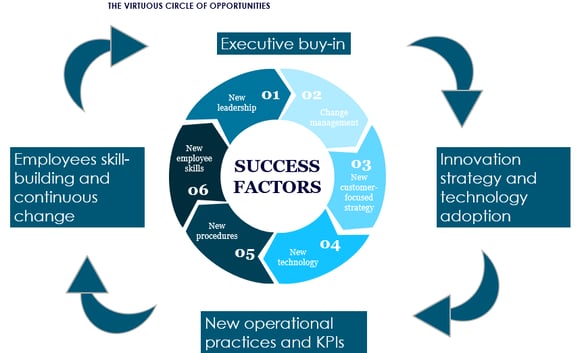Just before the majority of countries around the world went into lockdown, we (Pr. Martin-Rios from EHL and Pr. Chan from NY Institute of Technology) completed a report on the future of innovation for hospitality. HSMAI America commissioned a scenario study as part of the association's continued commitment to unfolding a vision of the current U.S. hospitality’s emerging sales, marketing and revenue optimization (SMRO) innovation strategic initiatives with its challenges and needs.
This report addresses best practices, success factors and challenges for the development of strategic innovation in hospitality in general, and specifically in the sales, marketing and revenue management functions. Despite the increase of industry awareness about the importance of formal innovation systems, many hospitality firms are still perceived as far from innovative. The report outlines three main findings:
- Little strategic innovation: Innovation in hospitality and particularly SMRM is risk averse, short-term focused and lacking a clear vision.
- Silo thinking stunts innovation: Despite sharing common innovation challenges, there are few synergies across functions and between organizations and stakeholders to foster innovation.
- Personalization and data: Predictive personalization by means of social media data emerged as the key innovation in data management strategy.
DOWNLOAD THE HSMAI SPECIAL REPORT NOW
A focus on the U.S.
Fieldwork and the writing phases of the project took place before the global disruption caused by the Coronavirus crisis. Interestingly, most of the results are highly applicable in the post-pandemic times.
Between September 2019 and February 2020, we asked American leaders from industry, consulting, non-profit and distribution what they thought strategic innovation would look like in the near future. We followed a threefold research procedure:
- Extensive revision of academic literature to uncover macro-strategic level issues: innovation strategy design and implementation, challenges and opportunities.
- Focus groups and expert opinion polls with 130 HSMAI experts to discuss key innovation topics.
- In-depth interviews with 17 key industry experts to explore (or achieve) consensus on disputed topics.
Interviewed experts were distributed between C-level, SVP/EVP, VP and Directors. Representing brands (20%); property management (50%) and consulting services (25%). Experts gave a detailed current state-of-the-art account on innovation in the US hospitality industry, with special emphasis on the sales, marketing and revenue operations.
The critical pillars of strategic innovation
Strategic innovation is the most sophisticated form of improvement. According to Markides, it is about re-imagining a company’s growth strategy by:
- Changing the rules of the game to redefine the business
- Redefining the who: Who is the customer?
- Redefining the what: What services to offer to these customers?
- Redefining the how: How to leverage existing core competencies to build new services?
Strategic innovation is both a process and an outcome. As a process, innovations can impact a corporation’s internal stakeholders (inward-facing), target end-users (outward-facing), draw from outside knowledge (open innovation) or respond to vertical integration and exclusive control (closed innovation).
As an outcome, innovations are defined in terms of their degree of newness or radicalness. Solutions that are new to an organization are counted among ‘incremental innovations’. A ‘radical innovation’ provides solutions that are ‘new to the world’.
Results from the study show different approaches between property management and owners as to how innovation should be approached and by whom (See Table).

We also found big differences across teams in sales, marketing and revenue management in their vision about what type of strategic innovation to pursue (see Table).

When asked about the future strategic innovation landscape, senior executives suggested three unranked main scenarios to inspire innovation:
- Co-creation of brands with customers, in which customers are ranked as more important than marketers themselves when it comes to influencing a brand’s reputation and hence are needed to get involved in partaking future change for the hospitality industry [i].
- Internal organizational change, where different company areas converge in a new, strategic department to work with and across existing departments. Despite the majority of respondents over-emphasizing technological developments and adoption, still some experts underlined these non-technological forms of innovation [ii]. This innovation scenario refers particularly to the marketing, sales and revenue management functions. Experts highlighted the absence of fluid dialogue among these three groups was detrimental to innovation. In fact, silo thinking stunts innovation.
- In short, experts bet on two innovations linked to a commitment to data science and technology to figure out forecasting and better pricing by segment:
“New online search strategies. A data-driven search strategy will only lead to hotel direct sites or channels that package components of a trip. Whether it be thru AI, voice search or bots, hotel sites will intuitively know the trip purpose and needs of the customer based on a few simple questions it will ask the customer. This intelligence will lead the customer to the best possible solution for their search.”
“Service platforms that provide guests with personalized services. Hotels will focus on increasing their visibility as a pivotal business with close ties to the community, or for brands or multi-unit firms, consider emphasizing partnerships with smaller companies and focusing their brand position around enriching local communities.”
Implementing strategic innovation
Senior executives were prompted to consider “What is needed to close the gap between the current state of the industry and where we want to be?” Answers include both challenges that hinder innovation, as well as opportunities and key success factors.
We combined answers into four dimensions and six factors (see Figure). First, senior management involvement is deemed critical to spurring novel forms of innovation. Second, successful innovation strategies and adoption must revolve around technological developments. Moreover, the establishment of KPIs linked to new SOPs is key to fostering accountability and ownership over new ideas. Finally, providing employees and managers with new skills and abilities to thrive in continuous changing environments will fortify existing initiatives and further strengthen executive buy-in.

Post-pandemic innovation landscape
The report highlights a gap between academic literature and experts. Existing literature on hospitality innovation suggests several salient topics that were not discussed by senior managers interviewed in this study. Particularly, experts overlooked sustainability and how to ensure a sustainable future, including framing green consumer behavior, sustainable growth, source of revenue and the creation, promotion and sale of sustainable products/services. Numerous studies have shown a relationship between innovation and sustainability (e.g. article and here)
Another important takeaway is that all experts agreed that the industry needs more not less innovation. This is particularly relevant in the face of the post pandemic crisis. Lessons learned from the past financial crisis (article) suggest that strategic innovation expansion (such as developing a formal innovation roadmap) yields higher returns than retrenchment (cutting costs) (article). In that sense, the current global pandemic crisis will force massive changes in a sector that has been ripe for innovation for a long time.
As one executive warned: “The challenges to implement best practices in innovation are numerous: we too often focus on short term, incremental, backward-looking innovation”.
Conclusion
Some companies talk the talk but are less keen on introducing an innovation agenda. Most experts suggested that short term priorities collide with demands for long term planning and, in turn, hospitality leaders are not prepared to take any risks and implement formal innovative practices.
As research shows (article), successful companies draw on seven factors to drive strategic innovation, namely: develop a vision, prepare a business case for innovation, celebrate innovative activities, bring in external stakeholders, spotlight quantifiable opportunities, formalize innovation in the structure, and outline a multidimensional innovation strategy and practice.
We hope this report contributes to shed light on how the pandemic crisis should change the way hospitality innovates while creating opportunities for adopting strategic innovation as a new foundation for hospitality fundamental renewal.
References
- Erhardt, N., Martin-Rios, C., & Chan, E. (2019). Value co-creation in sport entertainment between internal and external stakeholders. International Journal of Contemporary Hospitality Management, 31(11): 4192-4210.
- Markides, C. (1997). Strategic innovation. Sloan Management Review, 38, 9-24.
- Martin-Rios, C., & Ciobanu, T. (2019). Hospitality innovation strategies: An analysis of success factors and challenges. Tourism Management, 70, 218-229.
[i] For more detailed information about the importance of co-creation, see here.
[ii] For more detailed information about the importance of different forms of innovation, see this Hospitality Insights article, and this Innovation Report.







